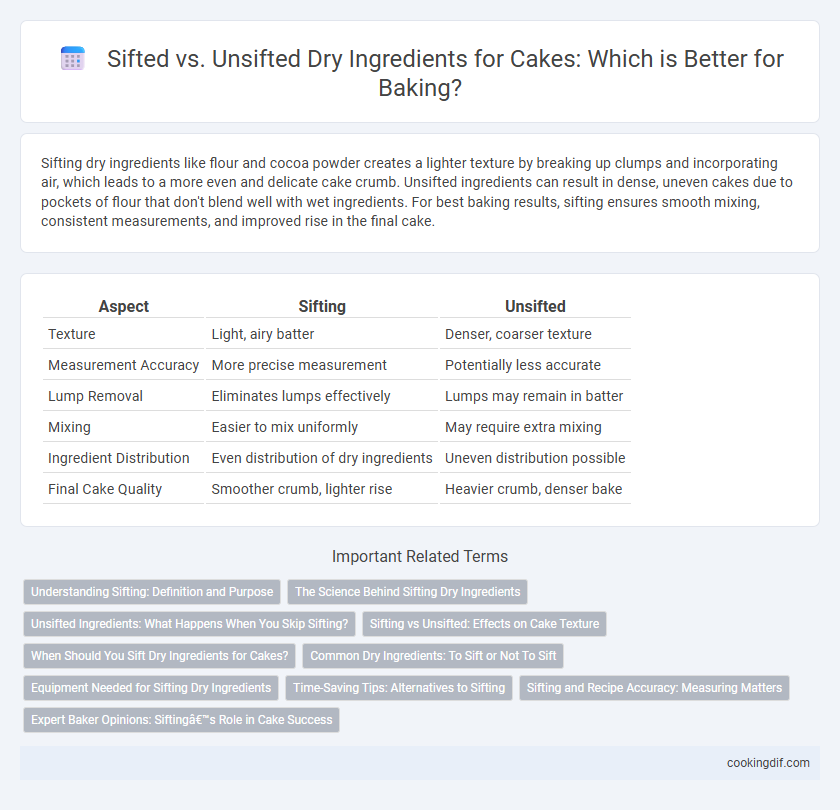Sifting dry ingredients like flour and cocoa powder creates a lighter texture by breaking up clumps and incorporating air, which leads to a more even and delicate cake crumb. Unsifted ingredients can result in dense, uneven cakes due to pockets of flour that don't blend well with wet ingredients. For best baking results, sifting ensures smooth mixing, consistent measurements, and improved rise in the final cake.
Table of Comparison
| Aspect | Sifting | Unsifted |
|---|---|---|
| Texture | Light, airy batter | Denser, coarser texture |
| Measurement Accuracy | More precise measurement | Potentially less accurate |
| Lump Removal | Eliminates lumps effectively | Lumps may remain in batter |
| Mixing | Easier to mix uniformly | May require extra mixing |
| Ingredient Distribution | Even distribution of dry ingredients | Uneven distribution possible |
| Final Cake Quality | Smoother crumb, lighter rise | Heavier crumb, denser bake |
Understanding Sifting: Definition and Purpose
Sifting dry ingredients involves passing them through a fine mesh sieve to break up clumps and aerate the mixture, ensuring a lighter, more uniform batter. This process helps evenly distribute leavening agents like baking powder and soda, preventing uneven texture and density in cakes. Unsifted ingredients may result in denser cakes with potential pockets of dry flour, affecting the final crumb and rise.
The Science Behind Sifting Dry Ingredients
Sifting dry ingredients like flour, cocoa powder, and baking powder aerates them, which helps to incorporate air and create a lighter cake texture. It also breaks up clumps and ensures even distribution of ingredients, crucial for consistent chemical reactions during baking. Using sifted ingredients improves the cake's rise and crumb structure by promoting uniform mixing and proper leavening agent activation.
Unsifted Ingredients: What Happens When You Skip Sifting?
Using unsifted dry ingredients in cake recipes can lead to uneven texture and dense crumb due to clumps of flour or baking powder. Skipping sifting may also cause measurement inaccuracies, resulting in imbalanced leavening and moisture levels. However, gently whisking the ingredients can sometimes mitigate these issues by distributing the components more uniformly.
Sifting vs Unsifted: Effects on Cake Texture
Sifting dry ingredients aerates the flour and evenly distributes leavening agents, resulting in a lighter and more tender cake crumb. Using unsifted flour can lead to dense, uneven textures due to clumps and inconsistent mixing. Proper sifting improves batter uniformity, enhancing the cake's rise and softness.
When Should You Sift Dry Ingredients for Cakes?
Sifting dry ingredients like flour, cocoa powder, and baking powder aerates them, preventing clumps and ensuring smooth, even mixing in cake batter. You should sift when recipes call for light, tender cakes such as sponge or chiffon, where a fine texture is essential. For denser cakes or when ingredients are pre-sifted, sifting may be optional, but it generally enhances consistency and volume.
Common Dry Ingredients: To Sift or Not To Sift
Sifting common dry ingredients like flour, cocoa powder, and baking powder ensures even distribution and prevents clumps, resulting in a lighter, more uniform cake texture. Unsifted dry ingredients can lead to uneven mixing, dense crumb, and potential baking inconsistencies. For recipes requiring precision, sifting improves aeration and enhances the overall structure of the cake.
Equipment Needed for Sifting Dry Ingredients
Using a fine-mesh sieve or a dedicated flour sifter is essential for sifting dry ingredients like flour, cocoa powder, and baking powder to remove lumps and aerate the mixture, ensuring a lighter cake texture. While unsifted dry ingredients can be measured directly, sifting requires minimal equipment but improves ingredient incorporation and final cake crumb structure. Opt for stainless steel or nylon mesh sifters for durability and ease of cleaning, enhancing baking precision.
Time-Saving Tips: Alternatives to Sifting
Using unsifted dry ingredients can save time without compromising cake texture when combined gently with other ingredients. Alternatives to traditional sifting include using a fine mesh strainer or a flour mill to aerate flour quickly and remove lumps. Incorporating these methods streamlines preparation while maintaining ingredient consistency for a tender crumb.
Sifting and Recipe Accuracy: Measuring Matters
Sifting dry ingredients like flour and cocoa powder aerates them, eliminating clumps and ensuring a consistent texture, which directly impacts recipe accuracy. Accurate measurement of sifted ingredients prevents dense or uneven cake batter, promoting optimal rise and crumb structure. Precision in sifting helps maintain the correct flour-to-liquid ratio, critical for achieving the desired cake texture and taste.
Expert Baker Opinions: Sifting’s Role in Cake Success
Expert bakers emphasize that sifting dry ingredients like flour, baking powder, and cocoa powder ensures even distribution and prevents clumps, which contributes to a lighter, more uniform cake texture. Unsifted ingredients can lead to dense, uneven crumb and potential baking inconsistencies, impacting the cake's rise and overall quality. Consistent sifting is regarded as a critical step in achieving professional-grade cakes with optimal fluffiness and structure.
Sifting vs Unsifted for dry ingredients Infographic

 cookingdif.com
cookingdif.com